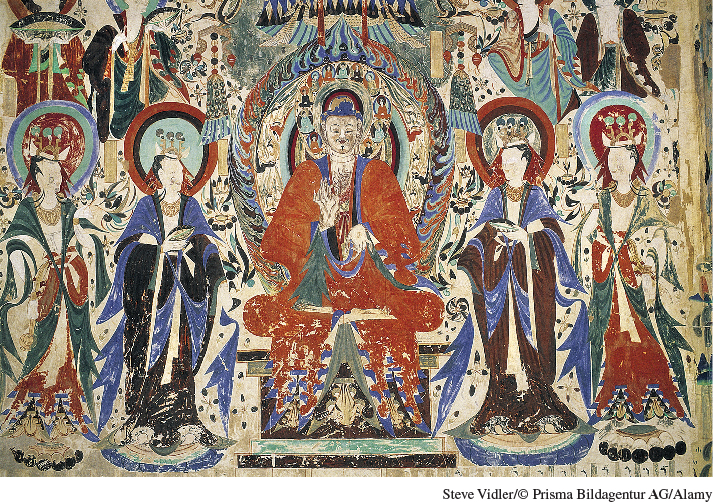Cultures in Transit
AP® EXAM TIP
Understanding that Buddhism, like other major religions, spread along trade routes is fundamental to success on the AP® exam.
More important even than the economic impact of the Silk Roads was their role as a conduit of culture. Buddhism in particular, a cultural product of Indian civilization, spread widely throughout Central and East Asia, owing much to the activities of merchants along the Silk Roads. From its beginnings in India during the sixth century B.C.E., Buddhism had appealed to merchants, who preferred its universal message to that of a Brahmin-dominated Hinduism that privileged the higher castes. Indian traders and Buddhist monks, sometimes supported by rulers such as Ashoka, brought the new religion to the trans-Eurasian trade routes. To the west, Persian Zoroastrianism largely blocked the spread of Buddhism, but in the oasis cities of Central Asia, such as Merv, Samarkand, Khotan, and Dunhuang, Buddhism quickly took hold. By the first century B.C.E., many of the inhabitants of these towns had converted to Buddhism, and foreign merchant communities soon introduced it to northern China as well.
Guided Reading Question
▪CHANGE
What accounted for the spread of Buddhism along the Silk Roads?
Particularly important in this process were the Sogdians, a Central Asian people, whose merchants established an enduring network of exchange with China. Two such Sogdians, living in China during the second century C.E., were instrumental in translating Sanskrit Buddhist texts into Chinese. Sogdians dominated Silk Road trade for much of the first millennium C.E., and their language became a medium of communication all along that commercial network. In their Central Asian homeland, however, Sogdians practiced Zoroastrianism, Manichaeism, and local traditions as well as Buddhism.

AP® EXAM TIP
Know examples of merchant groups who traveled far from their homes along trade routes, like the Sogdians.
Conversion to Buddhism in the oasis cities was a voluntary process, without the pressure of conquest or foreign rule. Dependent on long-distance trade, the inhabitants and rulers of those sophisticated and prosperous cities found in Buddhism a link to the larger, wealthy, and prestigious civilization of India. Well-to-do Buddhist merchants could earn religious merit by building monasteries and supporting monks. The monasteries in turn provided convenient and culturally familiar places of rest and resupply for merchants making the long and arduous trek across Central Asia. Many of these cities became cosmopolitan centers of learning and commerce. Scholars have found thousands of Buddhist texts in the city of Dunhuang, where several branches of the Silk Roads joined to enter western China, together with hundreds of cave temples, lavishly decorated with murals and statues.
Outside of the oasis communities, Buddhism progressed only slowly among pastoral peoples of Central Asia. The absence of a written language was an obstacle to the penetration of a highly literate religion, and their nomadic ways made the founding of monasteries, so important to Buddhism, quite difficult. But as pastoralists became involved in long-distance trade or came to rule settled agricultural peoples, Buddhism seemed more attractive. The nomadic Jie people, who controlled much of northern China after the collapse of the Han dynasty, are a case in point. Their ruler in the early fourth century C.E., Shi Le, became acquainted with a Central Asian Buddhist monk called Fotudeng, who had traveled widely on the Silk Roads. The monk’s reputation as a miracle worker, a rainmaker, and a fortune-teller and his skills as a military strategist cemented a personal relationship with Shi Le and led to the conversions of thousands and the construction of hundreds of Buddhist temples. In China itself, Buddhism remained for many centuries a religion of foreign merchants or foreign rulers. Only slowly did it become popular among the Chinese themselves, a process examined more closely in Chapter 8.
AP® EXAM TIP
You must know that major religions like Buddhism changed as they spread from their places of origin.
As Buddhism spread across the Silk Roads from India to Central Asia, China, and beyond, it also changed. The original faith had shunned the material world, but Buddhist monasteries in the rich oasis towns of the Silk Roads found themselves very much involved in secular affairs. Some of them became quite wealthy, receiving gifts from well-to-do merchants, artisans, and local rulers. The begging bowls of the monks became a symbol rather than a daily activity. Sculptures and murals in the monasteries depicted musicians and acrobats, women applying makeup, and even drinking parties.
Doctrines changed as well. It was the more devotional Mahayana form of Buddhism (see Chapter 4) — featuring the Buddha as a deity, numerous bodhisattvas, an emphasis on compassion, and the possibility of earning merit — that flourished on the Silk Roads, rather than the more austere psychological teachings of the original Buddha. Moreover, Buddhism picked up elements of other cultures while in transit on the Silk Roads. In the Sogdian city of Samarkand, the use of Zoroastrian fire rituals apparently became a part of Buddhist practice. And in the area northwest of India that had been influenced by the invasions of Alexander the Great, statues of the Buddha reveal distinctly Greek influences. The Greco-